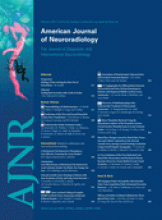Abstract
BACKGROUND AND PURPOSE: Clinical outcome and initial and midterm angiographic results of EVT of complex MCA aneurysms by using the stent-assisted coiling technique were retrospectively evaluated in our center where EVT of intracranial aneurysms is the first treatment option.
MATERIALS AND METHODS: From November 2003 to October 2009, 49 patients (27 men, 22 women; mean age, 52 ± 12 years) harboring 52 complex unruptured MCA aneurysms (11 ruptured previously and coiled but recanalized and 41 unruptured) were treated by EVT by using self-expandable intracranial stents. Procedural complications, clinical outcome, and initial and midterm angiographic results were evaluated. Initial treatment status and aneurysm sac size were tested as potential risk factors for recurrence.
RESULTS: After successful stent deployment, coiling was performed in 50 aneurysms (96.2%) in 47 patients; however, 2 failures (3.8%) occurred in 2 patients. Ten intrastent clot formations (20%) observed on final control angiography induced 2 permanent moderate disabilities (GOS score = 2). Mortality and permanent neurologic morbidity were 0% and 4.3%, respectively. At a mean period of 14 ± 9 months, among 48 aneurysms in 45 patients eligible for follow-up, 34 complete (71%) and 14 partial treatments (29%) were observed, 7 recurrences (14.6%) occurred, and 5 patients (10.4%) needed retreatment. No aneurysm bleeding or symptomatic intrastent stenosis was observed. Aneurysm sac size ≥7 mm and incomplete initial treatment were associated with more recurrences without a statistically significant difference.
CONCLUSIONS: For complex unruptured MCA aneurysms, EVT by using a self-expandable intracranial stent was feasible, safe, and durable and could be considered as the first-option treatment.
Abbreviations
- DSA
- digital subtraction angiography
- EVT
- endovascular treatment
- GOS
- Glasgow Outcome Scale
- MCA
- middle cerebral artery
- MRA
- MR angiography
- SAH
- subarachnoid hemorrhage
- Copyright © American Society of Neuroradiology












